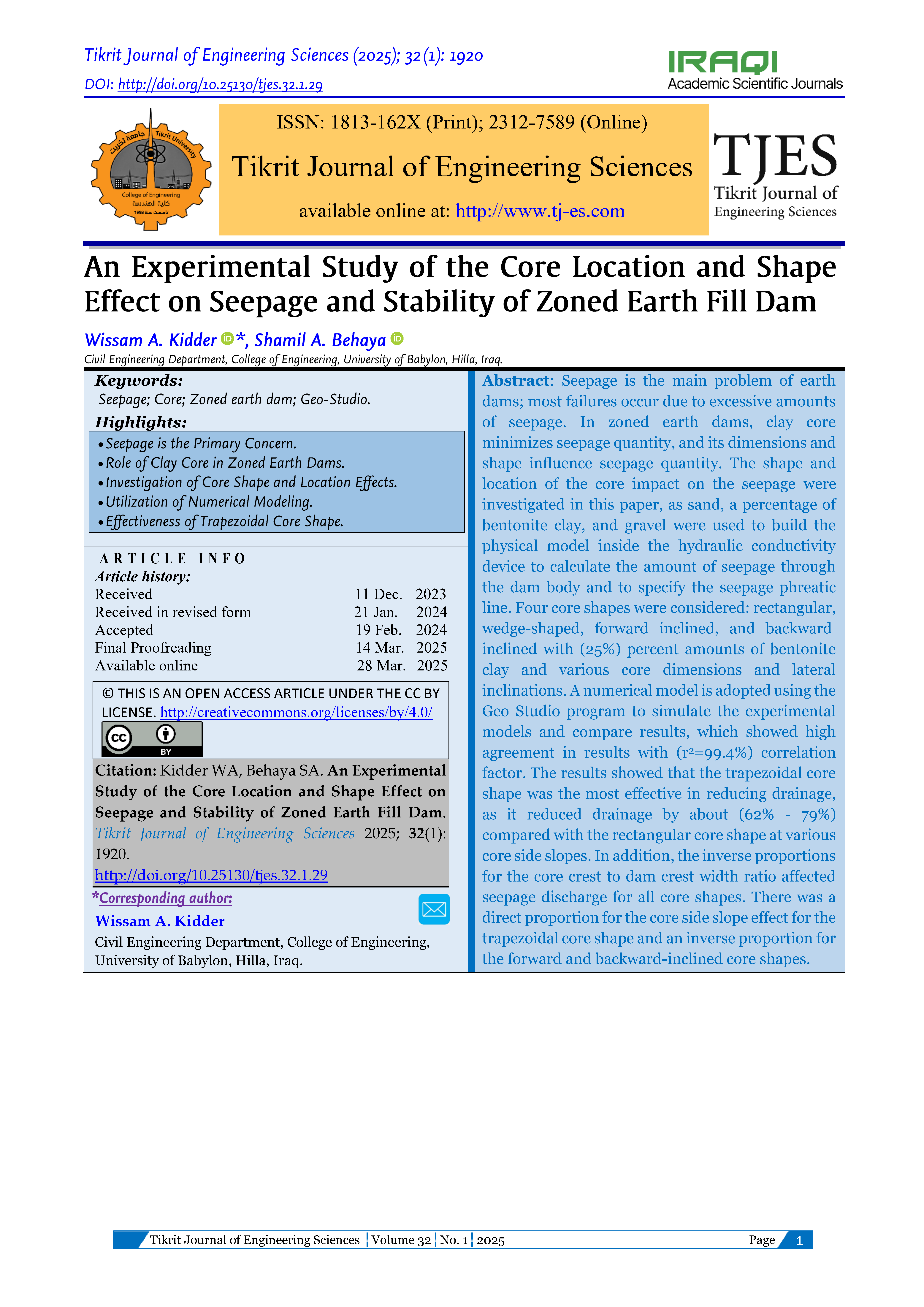An Experimental Study of the Core Location and Shape Effect on Seepage and Stability of Zoned Earth Fill Dam
Main Article Content
Abstract
Seepage is the main problem of earth dams; most failures occur due to excessive amounts of seepage. In zoned earth dams, clay core minimizes seepage quantity, and its dimensions and shape influence seepage quantity. The shape and location of the core impact on the seepage were investigated in this paper, as sand, a percentage of bentonite clay, and gravel were used to build the physical model inside the hydraulic conductivity device to calculate the amount of seepage through the dam body and to specify the seepage phreatic line. Four core shapes were considered: rectangular, wedge-shaped, forward inclined, and backward inclined with (25%) percent amounts of bentonite clay and various core dimensions and lateral inclinations. A numerical model is adopted using the Geo Studio program to simulate the experimental models and compare results, which showed high agreement in results with (r2=99.4%) correlation factor. The results showed that the trapezoidal core shape was the most effective in reducing drainage, as it reduced drainage by about (62% - 79%) compared with the rectangular core shape at various core side slopes. In addition, the inverse proportions for the core crest to dam crest width ratio affected seepage discharge for all core shapes. There was a direct proportion for the core side slope effect for the trapezoidal core shape and an inverse proportion for the forward and backward-inclined core shapes.
Metrics
Article Details

This work is licensed under a Creative Commons Attribution 4.0 International License.
THIS IS AN OPEN ACCESS ARTICLE UNDER THE CC BY LICENSE http://creativecommons.org/licenses/by/4.0/
Plaudit
References
Hasani H, Mamizadeh J, Karimi H. Stability of Slope and Seepage Analysis in Earth Fills Dams Using Numerical Models (Case Study: Ilam Dam-Iran). World Applied Sciences Journal 2014; 29(10):1398-1402.
Sazzad M, Alam S. Numerical Investigation of Seepage Through Earth Dam. 5th International Conference on Advances in Civil Engineering (ICACE-2021); 2021 December 16-18; Chittagong, Bangladesh.
Kheiri G, Javdanian H, Shams G. A Numerical Modeling Study on the Seepage Under Embankment Dams. Modeling Earth Systems and Environment 2020; 6(2):1075-1087. DOI: https://doi.org/10.1007/s40808-020-00742-9
Zahedi P, Aghazani HF. The Effect of Clay Core Specifications on the Seepage Behavior of an Earthfill Dam. 5th International Symposium on Dam Safety; 2018 November 12-14; Barcelona, Spain.
Li H, Zhao F, Li J. Seepage Analysis of Clay Core Wall Dam Based on ABAQUS. IOP Conference Series: Earth and Environmental Science 2019; 384(1):012015. DOI: https://doi.org/10.1088/1755-1315/384/1/012015
Jamel AA. Investigation and Estimation of Seepage Discharge Through Homogenous Earth Dam with Core by Using SEEP/W Model and Artificial Neural Network. Diyala Journal of Engineering Sciences 2018; 11(1):54-61. DOI: https://doi.org/10.24237/djes.2018.11309
Salmasi F, Norouzi R, Abraham J, Nourani B, Samadi S. Effect of Inclined Clay Core on Embankment Dam Seepage and Stability Through LEM and FEM. Geotechnical and Geological Engineering 2020; 38(6):6571-6586. DOI: https://doi.org/10.1007/s10706-020-01455-7
Abdel-Kawy AO, AboulAtta NM, El-Molla DA. Effects of Core Characteristics on Seepage Through Earth Dams. Water Practice and Technology 2021; 16(4):1248-1264. DOI: https://doi.org/10.2166/wpt.2021.053
Aziz YW, Ibrahim AH, Hamadamin KK. Effect of Core Shape and Its Side Slopes on Seepage Quantity of Zoned Earth Dam. Polytechnic Journal 2023; 12(2):1-12. DOI: https://doi.org/10.25156/ptj.v12n2y2022.pp1-5
Salem MN, Eldeeb HM, Nofal SA. Analysis of Seepage Through Earth Dams with Internal Core. International Journal of Engineering Research 2019; 8(10):768-777. DOI: https://doi.org/10.17577/IJERTV8IS080168
Refaiy AR, AboulAtta NM, Saad NY, El-Molla DA. Modeling the Effect of Downstream Drain Geometry on Seepage Through Earth Dams. Ain Shams Engineering Journal 2021; 12(3): 2511-2531. DOI: https://doi.org/10.1016/j.asej.2021.02.011
Bredy S, Jandora J. Effect of Dam Height on the Stability of Earth Dam (Case Study: Karolinka Dam). Journal of Engineering 2020; 26(3):117-126. DOI: https://doi.org/10.31026/j.eng.2020.03.10
El-Hazek AN, Abdel-Mageed NB, Hadid MH. Numerical and Experimental Modeling of Slope Stability and Seepage Water of Earthfill Dam. Journal of Water and Land Development 2020; 44(1):55-64. DOI: https://doi.org/10.24425/jwld.2019.127046
Alzamily ZN, Abed BS. Comparison of Seepage Through Zoned Earth Dam Using Improved Light-Textured Soils. Journal of Engineering 2022; 28(3):32-45. DOI: https://doi.org/10.31026/j.eng.2022.03.03
Aude S, Abdulhameed S, et al. Slope Stability and Soil Liquefaction Analysis of Earth Dams with a Proposed Method of Geotextile Reinforcement. GEOMATE Journal 2022; 22(94):102-112. DOI: https://doi.org/10.21660/2022.94.j2241
Zedan AJ. Performance Assessment of Shirin Earth Dam in Iraq Under Various Operational Conditions. Tikrit Journal of Engineering Sciences 2022; 29(2):61-74. DOI: https://doi.org/10.25130/tjes.29.2.8
Aziz YW, et al. Effect of Core Geometry on Earth Dam Slope Stability. Tikrit Journal of Engineering Sciences 2023; 30(2):41-45. DOI: https://doi.org/10.25130/tjes.30.2.5





